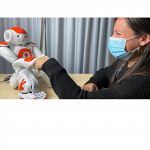Top 5 innovative tech of 2022
Bio-powered electronics. Kinetic floors. Turbine power. Magic wood. And mental health robots. These are just a handful of the innovative ways in which people, communities, and businesses are coming together to make a fun, interesting and greener future for everyone.
Now that 2022 is behind us, Electronic Specifier takes a look at five of the most interesting tech innovations of the last year.
1. Bio-powered electronics

A completely ‘green’ biofilm has been constructed by the University of Massachusetts Amherst. The secret of the biofilm lies in moisture from skin. The biofilm can “plug-in” and convert the moisture into energy.
In other words, your sweat can help powers small devices.
The biofilm is constructed from a sheet of bacterial cells which has been engineered to harvest the energy in evaporation and convert it into electricity. That electricity can then be used to power wearables – such as personal electronics and medical sensors.
Graduate student in electrical and computer engineering in UMass Amherst’s College of Engineering said: "This is a very exciting technology … It is real green energy, and unlike other so-called 'green-energy' sources, its production is totally green." Read more.
2. Kinetic floors (and stationary bikes)

Pop band Coldplay are not ones to shy away from the use of sustainable technology, and they have got their fans in on the act as well, with parts of their shows being powered by energy from the crowd – literally.
In a fun and innovative move, the band have utilised kinetic floors – so whenever fans jump, dance and generally have a great time, they are actually helping to power the show in a sustainable way.
But they go even further than that, with the use of exercise bikes.
By having audience members take to a spot of impromptu spinning, the band have instigated a novel way of utilising energy generation.
These innovations not only raise awareness of the importance of climate change and the need to update the way we, as a collective, think, but it also highlights that ways in which sustainability can be fun … And, if you missed a gym session to see the show, you’ll still get your work out in. A winner on all counts. Read more.
3. Turbine power

What do wind turbine blades, gummy bears, plexiglass, and nappies all have in common?
They all share carbon, and they have all derived from the same wind turbine blade – putting a whole new spin on the circular economy.
Wind turbines are a well-regarded means of renewable energy, and they must be strong and durable to work. In fact, the bigger the blade, the better the return on energy, which means that many turbine blades do not reach the end of their useful life before being changed for larger ones. Also, the mechanical part oftentimes outlives the blades. The result, an early end-of-life turbine blade, and a massive landfill problem.
Dr John Dorgan, Professor of Chemical Engineering and Materials Science at Michigan State University, led a research team who found that by manipulating the panels they could make a number of items from the old blades, including new turbine blades, sweets, drinks and casings for computers. Read more.
4. Magic wood

With billions of tons of plastic produced over the years, it is a sad and stark fact that a majority of that plastic has ended up in landfill, in our oceans, on our streets and in our environment in general.
With both companies and individuals beginning to realise the wider problem of single-use plastics, one research team from the VTT Technical Research Centre of Finland has come up with a novel way to fight back.
By using agricultural and forestry by-products, they have created a compostable multilayer material that replicates plastic.
The proprietary material can be used in place of ‘stand-up’ food pouches, like nuts, dried fruit and muesli. The wood by-products contain cellulose, this makes it an environmentally friendly alternative to fossil fuel-based, multi-layered plastic packaging. Read more.
5. Mental health robots

Mini robots assess children’s mental health.
During the COVID-19 pandemic, children were home schooled and kept apart from their friends, peers and the stability of a ‘normal’ routine, all of which affected their mental health and wellbeing.
A 2022 study carried out by roboticists, computer scientists and psychiatrists from the University of Cambridge found, from a study of a small pool of children, that they opened-up and shared ‘secrets’ with a little humanoid robot, offering it information that they hadn’t felt comfortable sharing via standard methods.
The children interacted with the robot for 45 minutes, during which time it asked them a series of questions. The findings were that children felt more comfortable confiding in the robot than they did an adult.
Although these robots are not a replacement for human assessment, it is believed that they will be able to pick up micro reactions from children before they become a bigger concern. Read more.


